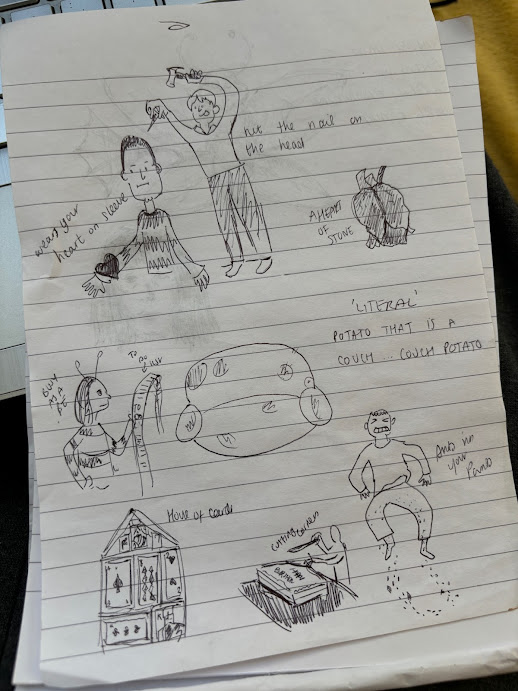Sequence and Narrative part 4: Description and Depiction 4.1
This exercise I chose to do when my Auntie and Uncle invited my family and I down to their caravan in Wales for a few days. I decided to draw us all sitting together one night on their caravan patio.
The way I framed the family was a little bit more head on like a higher view because I don’t know how else I would fit everyone in from the view I was looking, my auntie being left of me and my brother right.
The emotion and feeling of the pictures I have chose to match the mood at that time, there was a few laughs and memories shared so I kept a bit of a cartoony style with warm smiles. I did less of a realistic drawing because people were moving and talking so I just wanted to caoture the essence. You can see the subtle differences in each of the faces, my brother looking at his phone, my mum and auntie smiling and my dadand uncle contempt in the background.
How much of your own presence in the experience do you think comes through in your drawing and what is your intention when you draw?Are you a silent bystander or active participant?
I didn't add myself in this but in a way the drawing is sort of an unintentionally centred around me. You can see my legs at the bottom just to gage where I am in the scene. I did just focus on everything else though.
Are you looking to capture the objective reality of the situation or more a communication of how you see, feel, and engage with the world?
I think I've chose a more objective reality approach just not in a realistic style, I couldn’t really think of anything to suggest a feeling, but the use of expressions and friendly faces communicates a relaxed happy situation
What obstacles might you encounter if you attempt to draw only with ‘verisimilitude’ by which I mean exactly, as real, or as ‘true’ as the image in front of you?
I think an obstacle could be that there is no emotion or meaning being the image, it could be a flat boring drawing. Mine may be true to life but I still brought a bit of personality to the people in the scene. I also think using pure observation there’s no unique or imaginative qualities to look at I also may not be able to recreate the exact environment due to the composition of the image in general.
Reflection:
• Which approaches did you enjoy, and which will you take forward from this task?
I enjoyed describing the scene, It was like a diary entry where it was all true thoughts and involving all my senses when thinking about what’s around me gave me a new way in creating the scene in my head and how I feel. The use of describing things with words can promote new ideas of how to create that design wise, like using a certain medium to create a visual thing such as smell or taste.
• What happened when words and images interacted; did they reinforce or play off against each other?
When using just the words I could still visualise the scene in my head cause of where the words were situated, the use of words inside certain parts of the image were replaced by words that resemble the shapes of things or in place of the actual image like the moths and the dog being shaped by words.
• Did describing the scene using words first affect the way you drew afterwards?
It made it a more emotional response and the feeling of togetherness being happy with the family and then I was able to draw the simple shapes and expressions of everyone. It may not seem as meaningful how the drawings came out but they’re more a personal visual to me.
• Did what you described using words help you to decide the emphasis or your image?
‘Desperate flapping’ to describe the behaviour of the winged insects against the outdoor lights.
‘Peaceful and beautiful’ are how I would describe the site, behind us was a flowing river and the air was calm, and no other people were around us.
Cozy used when referring to the dog lying on the blanket and my family around me.











Comments
Post a Comment